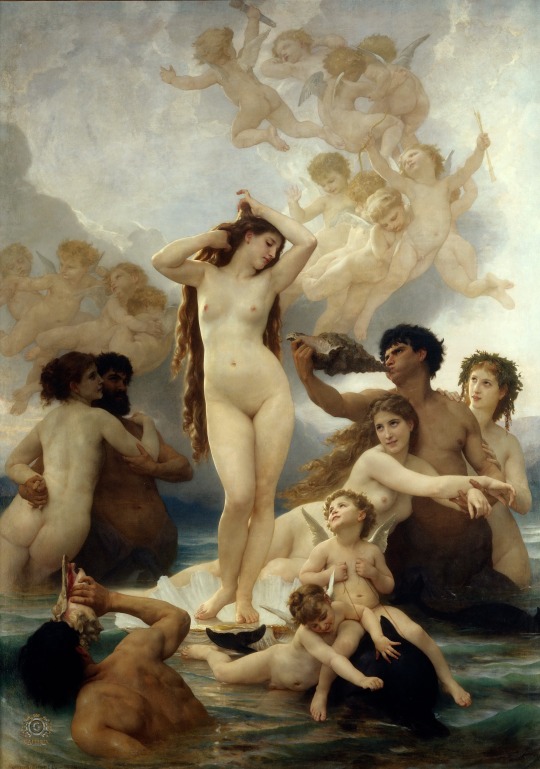Don't wanna be here? Send us removal request.
Text
Ch. 23 Nineteenth-Century Realism
In this chapter we see a wide scale of mediums but not subjects. This chapter starts with paintings, dips into photography, but also introduces the art of buildings and bridges. The first artist and painting that truly stuck with me was Thomas Eakin's Gross Clinic. With majoring in biology, this painting not only shows you the history of art but of science too. I found it interesting that Eakin chose to highlight only the doctor's forehead and the actual surgery. Those two points are the only points we should truly be concerned about. That "enlightenment" that he paints is another connection I realized. I tend to be a believer in that becoming an enlightened human being you must know more than just books. With the doctor's face being stern but calm, I tend to assume that surgery eases his mind. By doing surgery after surgery and after how many years, blood and bone do not even affect the doctor's thought process. I also found it interesting that Eakins painted many of his background subjects to be in all different body postures. You can even see some of them look to be looking away or covering up their face. This painting is a prime example of realism. Eakins not only shows us the realism of medicine an the education it takes. I also found it very soothing that Eakins uses the same hue of red that is in the patients blood but in the background and entryway.
0 notes
Text
Week 7 : Romanticism
This chapter was not my favorite chapter. I found that being "Romantic" is not the same as being romantic in 2017. Romanticism was hard to grasp. I understood the basics of this art style, but the wide scale of all the artist were so unique. The first artist that truly got my attention was Théodore Gericulat. I was interested because instead of using his gift to paint just anything, he choses to paint subjects that have injustice or very unique. His love for the human psychology was another reason I liked him. I am a biology major, so the fact that he sees objects like I do, I understand why he chose his subjects. Another artist I actually loved was Francisco de Goya y Lucientes. His dark paintings really got my attention. I have a love for the thrill movies and mystery books, so when I learned that he painted children's nightmares or things that are scary I had to do more research. Lucientes reminded me of the painter Francis Bacon. He, too, paints with a more dark side and weird subjects. Many artists in this time period painted subjects of political power or royalty but Lucientes used his artwork to paint more of things that interested him. Every artist this chapter were so unique that Thomas Cole seemed kind of the black sheep of the chapter. The way that he used landscapes to communicate through his art is very empowering. Many of his pieces have some sort of a storm or the aftermath of a storm. I think when he learned how beautiful the United States is and how a storm creates beautiful colors in the sky, he felt like a storyteller. I was happy that he chose to stray away from self portraits or pieces of political power, like the other artists. Like many chapters before, artists usually all have the same style and technique. In chapter twenty-two, I had the feeling that many artists were learning and trying to think for themselves. With the rise of Philosophy, I can understand why. Paintings of the unknown and mysteries fits with Philosophy. This chapter was so different, but yet very familiar and intriguing.
0 notes
Text
Week 5 : chapter 19 & 20
Ch. 19 - The Baroque Style
Throughout chapter nineteen, I was intrigued. In this time period, the laws of gravity were discovered and philosophy became very popular. Also, allegories were also featured in paintings. I am fan of the Baroque style of art and architect, even though some can become too elaborate or overdone, I am a fan. One reason I enjoy this style is the way many artists still use the contrast between light and dark. In the past, many artists that use that such drastic contrast is to show the influence or meaning of God vs. evil. The artist known as Caravaggio, uses this style in his painting The Calling of Saint Matthew. The artist Artemsia Gentileschi is one if my favorite in this chapter. Learning that her style of paintings were very Old Testament and violent, especially towards women. In our book, it states that she was one of the first artist of her time and she was a feminist, which I agree with. After learning more about Artmenisa’s life and the reason behind her style of violence, I can deeply understand why she paints what she paints. In my opinion, I feel like maybe painting was her therapy for what she had to go through.
Ch. 20 - Rocco and Revival Style In this chapter, all the paintings and artists remind me of make believe things you see on TV. Before now, many paintings were often religious or self portraits. With all the changes in politics, religion, philosophy, and even science, its understandable to see the switch if style and subjects. The Rocco style of paintings were often used with fairies or cupids in the backgrounds. One painting that I actually amazing was Jean-Honoré Fragonard’s 1766 “The Swing”. The book states that you can see the same style of brush strokes. In this painting, the trees, the clouds, and even the womens dress all have the same cloud-like style. Also, you can see hidden in the background is cupid.
One reason why I also enjoyed this chapter, is the victory for all the females. In this chapter we learn about so many women and what influences them to paint. Its important to realize that these women were painting and studying, when women really were not entitled to a voice. We can also see the shifts of subject matter. This chapter stills has religious and self portraits, but switches to many everyday subject matters to fantasy subject. The revival style of architect reminds me of many buildings or schools that we have today. Even though I love the elaborate style of Baroque or even Rocco, many of the rulers that enjoyed this style could actually afford it. In today’s society, we have been able to have the knowledge of saying, just because I have the money to buy something, doesnt mean I have to buy it. Lord Burlington’s house and Horace Wadpole’s house are very similar. Both architect have clean,smooth walls and simple layout. In the past, many rulers have gone very elaborate with curved columns and subjects carved into the buildings, which now seem a bit too unnecessary.
0 notes
Photo

Two Shepherd Boys by Carl Frederic Aagaard, 1885
204 notes
·
View notes
Text
Sixteen Century Painting and Printmaking in Northern Europe.
As each chapter is read, we learn more and more about different artists along with their influences. One artist that truly stuck out to me was Albrecht Dürer. Learning about his different influences and what type of style he uses, is what interested me. I, too, am a big fan of Leonardo da Vinci. By comparing Dürer's self portrait and the Mona Lisa, you are able to see what connections are important to Dürer's style. As I read more about Dürer's prints, the depth of how connected and educated with his pieces he truly was. His famous piece Melencolia portrays an artist that has all this talent and tools but has no inspiration. In the foreground, sits a cow, which I thought was oddly for this type of 'religious" painting. As I read the history paragraphs beneath, the reason for the cow is to show the unity between farmers, artists, and geometricians. Throughout this chapter I have seen and read the connections the artists have with the influences around them along with their religious beliefs. I also have noticed the huge impact that "proverbs" had. Even today, many people live their life by religious proverbs. In Bruegel's Netherlandish Proverbs, we can see many of these proverbs that were alive in 1559 are still alive today. This painting proves the importance of storytelling and the impact of art over time. Another interesting point about this piece is that no matter what type of proverb you decipher, you will be right. This painting is truly up to the beholder on what proverb or life lesson you can see.
1 note
·
View note
Photo

Genrikh Semiradsky (1843-1902), “The New Bracelet”
7K notes
·
View notes
Photo

Detail of The Darnley portrait of Queen Elizabeth I, 1575, Unknown Dutch artist #historyofart #arthistory #art
47 notes
·
View notes
Photo

Empress of Austria (1865) by Franz Xavier Winterhalter #art #historyofart #arthistory
438 notes
·
View notes
Photo

Water Boat Fountain in Playa de la Malvarrosa in Valencia, Spain
Photo source: Nors
2K notes
·
View notes
Photo

William-Adolphe Bouguereau (1825 – 1905) - The Birth of Venus (фр. La Naissance de Vénus)( 1879 ).
Адо́льф Вилья́м Бугро́ (1825 – 1905) - Рождение Венеры( 1879 ).
3K notes
·
View notes
Photo
I really enjoyed this sculpture that Natalie shared. This piece can relate to every single person. We all have had those battling moments in relationships with others. As a mother, this also relates to me, due to the fact that I know how hard it is to try to balance a relationship along with parenthood.

The sculpture called “Love,” created by Alexandr Milov is so powerful to me. It represents two adults in an argument (backs to each other and their heads bowed) while their inner child just wants to love each other and to stay connected. This could be any kind of relationship; lovers to lover, parent to children, etc. Sometimes in relationships there is nothing more damaging than pride and I think this sculpture really captures that.
3 notes
·
View notes
Photo

“Vortex” 2008 by Gregory Thielker
http://www.gregorythielker.com/
Gregory Thielker is another artist who is talented. I have always been in dumbfounded by his work with oil on canvas. the fact that most of his paintings look like photography is another reason I enjoy his work.
0 notes
Photo

Swans Reflecting Elephants, 1937 by Salvador Dali
One of my favorite artists is Salvador Dali. We all know his famous painting “Melting Clocks”, but this painting has always struck me as interesting and one I love. Not only is his art, so unique, more like a trademark for him, but they are highly detailed. It amazes me how talented some artists truly are. Another reason why he is one of my favorites is because he was kind of a mad man. He created art that he wanted to create, no matter how many heads turned. He embraced his weirdness and become famous because of it.
1 note
·
View note










